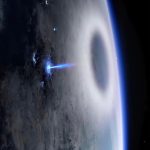Key Takeaways
- The Sombrero Galaxy, also known as Messier 104 or NGC 4594, is a lenticular galaxy located between the Virgo and Corvus constellations.
- It was first discovered by French astronomer Pierre Mechain in 1781 and later connected to observations made by German astronomer William Herschel.
- The galaxy features a prominent dust lane in its inclined disk, giving it the appearance of a sombrero hat, which is how it got its name.
- The Sombrero Galaxy’s nucleus contains a supermassive black hole and is classified as a low-ionization nuclear emission-line region (LINER).
- It can be found approximately 31.1 million light-years away from our Solar System and is visible with amateur telescopes.
The Sombrero Galaxy, also known as Messier 104 or NGC 4594, is a fascinating lenticular galaxy that captivates astronomers and stargazers alike. Situated between the borders of the Virgo and Corvus constellations, it was first discovered by French astronomer Pierre Mechain on the 11th of May, 1781. Mechain’s observations were later connected to those made by German astronomer William Herschel in 1784, who noticed a distinct “dark stratum” in the galaxy’s disc, now known as a dust lane. The Sombrero Galaxy’s unique appearance, with its prominent dust lane and unusually large central bulge, earned it the name “Sombrero” due to its resemblance to the traditional Mexican hat.
The nucleus of the Sombrero Galaxy presents a fascinating characteristic known as a low-ionization nuclear emission-line region (LINER). This phenomenon involves ionized gas with weakly ionized atoms, suggesting the presence of a supermassive black hole. While the nucleus appears to be devoid of star formation regions, astronomers have discovered a supermassive black hole at its core, likely responsible for weakly ionizing the gas. The presence of such a massive black hole is remarkable, as it is among the most massive ever found in nearby galaxies, boasting around 1 billion times the mass of our Sun.
Observing the Sombrero Galaxy is an exciting endeavor for amateur astronomers. Located at a distance of approximately 31.1 million light-years away from our Solar System, it is positioned within the zodiacal constellation of Virgo, close to the constellation of Corvus, the celestial crow. Finding the galaxy can be accomplished by locating it 11.5 degrees west of the bright star Spica in Virgo or 5.5 degrees northeast of Eta Corvi in Corvus. The Sombrero Galaxy’s apparent magnitude of +8.0 makes it visible with 7×35 binoculars or a 4-inch amateur telescope. To distinguish its bulge from the disk, an 8-inch telescope is needed, while a 10- or 12-inch telescope is required to observe the dark dust lane.
The Sombrero Galaxy’s vastness is awe-inspiring. With a diameter of around 49,000 light-years, it is approximately 30% the size of our Milky Way galaxy. Additionally, it boasts a relatively large number of globular clusters, estimated to be between 1,200 and 2,000. This abundance of globular clusters in relation to its total luminosity sets the Sombrero Galaxy apart from our own galaxy. These characteristics make the Sombrero Galaxy a subject of great interest and research for astronomers, as it provides valuable insights into the nature and evolution of lenticular galaxies and the role of supermassive black holes in their formation and dynamics.
Read full article on The Nine Planets
#1

By Lee Dyson
#2

Sombrero Galaxy by Mark Casto, Halesworth, Suffolk, UK. Equipment: Skywatcher 200p on an EQ5 mount, Canon 350D modded camera.
#3

M104 Sombrero Galaxy by Mark Griffith, Swindon, Wiltshire, UK. Equipment: Celestron C11 Sct, Skywatcher NEQ6 pro mount,Atik 383L+ camera, motorised filter wheel and Astronomik filters.
#4

Sombrero Galaxy by Scott Phillips, Wales, UK. Equipment: Iphone 5a, Orion SteadyPix Adapter, NightCap Pro App
#5

The picture is composed of four images taken at 3.6 (blue), 4.5 (green), 5.8 (orange), and 8.0 (red) microns. The contribution from starlight (measured at 3.6 microns) has been subtracted from the 5.8 and 8-micron images to enhance the visibility of the dust features. Credit: NASA/JPL-Caltech and The Hubble Heritage Team (STScI/AURA)
#6

Credit: AstroBackyard
#7

One of the first images taken by the Discovery Channel Telescope was of the Sombrero Galaxy, M104. The image was obtained April-May 2012. (Image credit: Lowell Observatory)
#8



